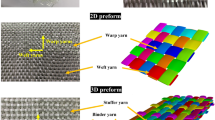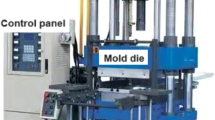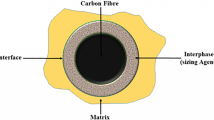Abstract
In the recent development of structural composite materials, there is an approach to enhancing existing and synthesis of new, strong, and resistant fibers, and there is an approach to the synthesis of more efficient interlayer adhesives and polymer matrices. This research considers potential new hybrid composite binders based on epoxy resin and poly(vinyl butyral), PVB, reinforced with nanostructures of several engineering ceramics: SiC, INT-WS2, BN, and B4C. First stage of the research consisted of preparation and examination of hybrid polymer matrices in the form of thick films for characterization. FTIR was applied to confirm the chemical interaction between the two polymer components and to exclude their chemical interaction with the nano reinforcement. Mechanical performance was examined through tensile test and hardness measurement. The addition of nano reinforcements has improved tensile strength and the Shore hardness values of composite polymer matrix films, especially in the case of INT-WS2. The second stage of research was the implementation of the reinforced binders in carbon fiber laminated composites. INT-WS2 reinforced composite was selected and examined through tensile testing and resistance to bending test. Results obtained encourage further research and more detailed characterization of the new composites for potential application in the automotive, naval, and aerospace industries, in civil engineering, protective equipment, etc.
Access provided by Autonomous University of Puebla. Download conference paper PDF
Similar content being viewed by others
Keywords
1 Introduction
Novel composite materials are taking precedence over conventional metal materials that were earlier mostly used in the construction of aircraft structures, providing reduced final weight of the aircraft structural components, corrosion resistance, and improved fatigue performance. Typical composites in aerospace engineering are fiber-reinforced polymer composites (FRPs), consisting of different types of matrices (polymeric, ceramic, and metallic) reinforced with high-strength fibers or fabrics. Most of the polymer composites used in construction of light-weight aircraft consist of thermoset and thermoplastic polymers, and commonly used fibers are carbon, aramid, or glass fibers (Rana & Fangueiro, 2016; Ramli et al., 2022; Baker et al., 2004; Soutis, 2005). Some important performance properties should be fulfilled when designing composite materials for aerospace structures: these materials should have high static strength, high-impact resistance, high fracture toughness, and damage tolerance, as well as resistance to different environment conditions during the exploitation (Rana & Fangueiro, 2016; Linganiso & Anandjiwala, 2016). Nowadays, additional improvement of the mechanical performance of these composites is achieved by including various reinforcing fillers, like some functional nanomaterials, or chemical modifications of the matrix-fibers interface. As reinforcement, nanomaterials are characterized by high surface area and better interface, smaller defects, and low volume fraction required for property enhancement.
In this research, a combination of a thermosetting and thermoplastic polymer has been chosen: epoxy resin modified with poly(vinyl butyral), PVB, and the following nanoceramic structures have been selected as reinforcement of the hybrid binder: boron nitride nanoparticles (BN), silicon carbide nanofibers (SiC), tungsten disulfide nanotubes (INT-WS2), and boron carbide nanoparticles (B4C), and further, laminated composite based on carbon fibers. The selection of the applied nanostructures was done in accordance with their well-known mechanical strength and hardness. The term nanoceramics refers to ultrafine particles, less than 100 nm in diameter, and are classified as inorganic, heat resistant, non-metallic solid materials. From the aspect of chemical composition, the most important engineering ceramic materials are metal oxides, carbides, borides, nitrides, and some sulfides. Nanoceramics show great resistance against compression and bending. Their strength is similar to that of steel, and most ceramics maintain their strength at high temperatures. However, their brittleness is a drawback for employment in load-bearing applications (Taylor-Smith, 2019; Bensal, 2005). This brittleness can be reduced by reducing the size of the grain used in making these materials, like downsizing them to nanoscale. Nanoceramics might even find use in armor for greater protection against blunt trauma and high-velocity ammunition (Bansal, 2005; Simić et al., 2019). Tungsten disulfide nanostructures in the shape of fullerene-like nanoparticles and nanotubes, IF-WS2 and INT-WS2, exhibit exceptional thermal and mechanical resistance, shock and pressure resistance, and well-known solid lubricating behavior. Due to these properties, they have already been studied as reinforcement in composites for demanding applications in personal protection equipment, ballistic protection, sports equipment, automotive, nautical, and aircraft engineering (Simić et al., 2019; Tenne, 2006; Tenne & Redlich, 2010). Silicon carbide (SiC) is the third hardest material after diamond and boron nitride. Due to its great hardness, it has been used as an abrasive in materials for car brakes, car clutches, and ceramic plates in bulletproof vests (Cheung, 2006; Locke et al., 2012). Boron nitride has extremely high hardness, due to which it is used for high-speed cutting tools and for metal forming. As a heat-resistant material, it is applied as a high-temperature solid lubricant in the aerospace industry, heat shielding materials, etc. (Gonzales-Ortiz et al., 2020; Gao et al., 2020). Boron carbide has very high melting, boiling points, and flexural strength, so it has been applied as filler for high-performance composites. It also shows excellent temperature and wear resistance, strength, hardness, and elastic modulus (Chinthamani et al., 2020; Ubaid et al., 2017).
2 Materials and Methods
In the first research stage, hybrid polymer matrix samples were prepared, with and without adding nanoceramic structures. The following materials were used: epoxy resin L385 with hardener 386, Hexion; PVB powder Mowital B60H, Kuraray; nanotubes of INT-WS2, outerdiameter 80–100 nm and length 10–20 μm, NanoLub, ApNano; nanofibers of SiC, Sigma Aldrich; BN, 70–80 nm, US Research Nanomaterials Inc.; B4C, hexagonal, 45–55 nm, US Research Nanomaterials Inc. PVB was mixed with component A of the epoxy resin before the addition of component B. After complete homogenization of a vertical mechanical stirrer, the mixture was cast in a flat mold to solidify in the form of a thick film, from which the specimens were cut out for tensile test, as shown in Fig. 1. Epoxy and PVB were mixed in ratio 95:5 in wt.%. For the samples with nanoreinforcements, the selected nanostructures were dispersed and deagglomerated with an ultrasonic probe prior to the homogenization of the polymer matrix. The nanostructures, regarding the total amount of polymers epoxy/PVB, were added in different concentrations chosen according to earlier researches and findings: 0.3 wt.% SiC, 0.5 wt.% INT-WS2, 1 wt.% BN, and 1 wt.% B4C (Marjanović et al., 2018, 2021; Simić et al., 2019).
In the second stage, laminated composites were prepared by impregnating carbon-epoxy prepreg with unidirectional fibers (HAUFLER Carbon fiber, aero quality) with the prepared mixtures of polymers with one selected nanoreinforcement: INT-WS2. Composites were made by laminating 8 layers of carbon for tensile test and 10 layers for bending test in two fiber orientations: 0° and 0/90°. Laminates were pressed under thermal press Belišće at 5 bar and 130 °C. After the curing reaction of the resin took place, the specimens for mechanical testing were cut, as shown in Fig. 2.
Fourier transform infrared spectroscopy – FTIR analysis was performed using device Nicolet™iS™ 10 spectrometer (Thermo Fisher Scientific) with Attenuated Total Reflectance (ATR) sampling, with the aim to examine if there occurred any chemical interaction of the two combined polymers with the added nanostructures.
Mechanical testing of thick polymer films was done in two methods: tensile strength of the thick composite films was examined using the universal testing machine INSTRON 1122, and five specimens were tested for each composite. The hardness of thick solid film samples was measured using a Zorn Stendall DDR device, in Shore D scale for plastics, in 5 measurements per sample.
Mechanical testing of carbon fiber composites included tensile test and bending test. A tensile test was performed using the SHIMADZU SERVO PULSER device on specimens of an average width of 15 mm and thickness of 3 mm, on five samples of each composite type. The test was done at a temperature of 20 °C, tensile speed of 1 mm/min, and pressure in the clamps 9 bar. A bending test was done on the SCHENK TREBEL RM 100 testing machine. Test specimens had an average width 12 mm and an average thickness of 4 mm. The bending speed was 1 mm/min, the support span 128 mm, and the radius of the pressing tool was 3 mm.
3 Results and Discussions
3.1 FTIR Results
The registered FTIR spectra for the examined composites are given in Fig. 3.
The following peaks were registered originating from PVB structure: a broad peak between 3350 and 3450 cm−1 for OH, at 2850 and 3000 cm−1 for CH3, CH2 and CH, at 1400 and 1280 cm−1 for alkynes, at 1740-1750 cm−1 for C = O, at 1200 cm−1 for ester group, at 1100 cm−1 for C–O–C and at 950 cm−1 for the acetal group. The following peaks originated from epoxy resin: at ~920 and 1670 cm−1 for the vibrations of the epoxy ring and aldehyde groups.
Since the curves are practically the same for all the examined polymer matrix samples, without and with different nanoceramics, it may be concluded that these structures are inert, i.e., there is no chemical interaction between the added nanostructures and polymers. Therefore, the reinforcing effect of individual nanostructures is a consequence of their physical properties, i.e., their proper mechanical resistance.
3.2 Hardness Results
The results of hardness measurements of nanoreinforced polymer thick films are given in Table 1.
For all the samples containing nanoceramics there may be observed an increase in the Shore hardness (ShD), while the best results were achieved with INT-WS2 (~19%) and for SiC (~15%). The reason for such results, besides the intrinsic properties of the two nanoceramics, is the shape of the used nanostructures: nanotubes and nanofibers.
3.3 Tensile Test Results
Tensile test resulted in registering force-displacement curves, i.e., dependencies stress-strain. These curves for the five examined specimens of epoxy/PVB polymer thick film with nanofibers of SiC are given in Fig. 4.
Mean values of maximum force and displacement, as well as stress and strain values, are summarized in Table 2.
From the observed results, it is evident that the most significant increase of the maximum tensile force was achieved in BN and INT-WS2, where the increase of maximum force was ~127% and ~143%, respectively, but the tensile strength was significantly increased only for BN, for 88%. For other nanoceramics, there were no improvements. This is probably due to the poor molecular interaction of the incorporated nanostructures with the polymers in the hybrid system. Namely, this kind of nanocomposites consists of a polymer matrix as a continuous phase, with nanoscale filler dispersed as a discontinuous phase. It is known that the nanostructures added to the polymer continuous phase can modify the properties of the continuous phase due to their geometry and size, changing the physical and chemical complexity of the polymer matrix (Bustamante-Torres et al., 2021), even causing deterioration of tensile strength of the hybrid polymer matrix.
CFRP composites results – the obtained values of maximum force, tensile strength, elongation, and calculated Young modulus are given in Table 3.
Observing the results for fibers orientation 0°, it is evident that WS2 nanotubes have caused an increase in tensile strength of 27.8% and an elongation of 10.4%. This is because the polymer matrix carries the load here, so when it is reinforced, it gives a more obvious improvement. Unlike that, in case strong carbon fibers carry part of the load, the improvements are insignificant. For fibers oriented at 0/90°, tensile strength increased by 5.3% and the elongation by 9.7% due to added nanotubes.
3.4 Bending Test Results
Bending test results are presented in Table 4: Fmax – maximum force, L – support span, m – slope of the secant of the load–deflection curve, Ef – flexural modulus of elasticity, ε – maximum strain at the outer surface at mid-span of the specimen, σ – maximum flexural stress at the outer surface at mid-span of the specimen.
For the samples with carbon fibers oriented at 0°, there practically is no difference in bending resistance. However, for the samples with fibers oriented at 0/90°, there is an evident improvement – an increase in σmax for 12.4% and E, for 14.5%. Bending resistance is important for components that are subjected to bending loads during operation, as both the flexular strength and the flexural modulus.
4 Conclusion
Nanostructures of engineering ceramics have been applied to reinforce epoxy/PVB system-polymer matrix for composite materials: SiC, INT-WS2, BN, and B4C. Samples with and without reinforcement were examined in two stages: in the form of thick solid films and carbon-fibers laminated composites for the mechanical tests. FTIR analysis has demonstrated that there were no chemical reactions between the reinforcements and polymers, so the reinforcing effect is based on the properties of the nanostructures and potential physical interaction with the matrix. Hardness was most improved with the addition of INT-WS2 (~19%) and SiC (15%). Tensile test of thick plastic films has shown that in the case of BN, there is the most prominent increase of tensile strength (88%). For the carbon fibers-based CFRPs, INT-WS2 was selected as reinforcement, and the addition of it has been shown to induce an increase in tensile strength for fibers orientation 0°, at 20%, and for fibers oriented at 0/90° at 57%. Bending resistance increased for the samples with fibers oriented at 0/90° (σmax increased by 12.4% and E by 14.5%) with the addition of INT-WS2. Final application of the new reinforced composites may be in the automotive, naval, and aerospace industries, in civil engineering, as protective panels, for sports equipment, etc.
Abbreviations
- FRPs:
-
Fiber-Reinforced polymer composites
- PVB:
-
Poly(vinyl butyral)
- SiC:
-
Silicon carbide
- INT-WS2:
-
Inorganic nanotubes of tungsten disulfide
- BN:
-
Boron nitride
- B4C:
-
Boron carbide
- FTIR:
-
Fourier transform infrared spectroscopy
- ATR:
-
Attenuated Total Reflectance
References
Baker, A., Dutton, S., & Kelly, D. (2004). Composite materials for aircraft structures (2nd ed.). American Institute of Aeronautics and Astronautics. Inc.
Bansal, N. P. (2005). Handbook of ceramic composites (p. 312). Springer. ISBN 978-1-4020-8133-0.
Bustamante-Torres, M., Romero-Fierro, D., Arcentales-Vera, B., Pardo, S., & Bucio, E. (2021). Interaction between filler and polymeric matrix in nanocomposites: Magnetic approach and applications. Polymers, 13, 2998.
Cheung, R. (2006). Silicon carbide microelectromechanical systems for harsh environments (p. 3). Imperial College Press. ISBN 978-1-86094-624-0.
Chinthamani, S., Kannan, G., George, G. D., Sreedharan, C. E. S., & Rajagopal, K. S. (2020). Effect of nano B4C on the tribological behaviour of magnesium alloy prepared through powder metallurgy. Materials Science, 26(4), 392–400.
Gao, C., Zhu, Z., Shen, Y., Wang, T., & Xiang, D. (2020). Efficient construction of boron nitride network in epoxy composites combining reaction-induced phase separation and three-roll milling. Composites Part B: Engineering, 198, 108232.
Gonzalez-Ortiz, D., Salameh, C., Bechelany, M., & Miele, P. (2020). Nanostructured boron nitride–based materials: Synthesis and applications. Materials Today Advances, 8, 100107.
Linganiso, L. Z., & Anandjiwala, R. D. (2016). Fibre-reinforced laminates in aerospace engineering. In S. Rana & R. Fangueiro (Eds.), Advanced composite materials for aerospace engineering (pp. 101–127, ISBN 9780081009390). Woodhead Publishing. https://doi.org/10.1016/B978-0-08-100037-3.00004-3
Locke, C. W., Severino, A., La Via, F., Reyes, M., Register, J., & Saddow, S. E. (2012). Chapter 2 – SiC films and coatings: Amorphous, polycrystalline, and single crystal forms. In S. E. Saddow (Ed.), Silicon carbide biotechnology (pp. 17–61, ISBN 9780123859068). Elsevier. https://doi.org/10.1016/B978-0-12-385906-8.00002-7
Marjanović, M., Bajić, D., Perković, S., Fidanovski, B., Burzić, Z., Matija, L., & Bekrić, D. (2021). Inorganic fullerene-like nanoparticles and nanotubes of tungsten disulfide as reinforcement of carbon-epoxy composites. Fullerenes, Nanotubes, and Carbon Nanostructures. https://doi.org/10.1080/1536383X.2021.1928644
Marjanović, M., Simić, D., Perković, S., Galović, J., Burzić, Z., Tasić, A., & Grga, S. (2018). Analysis of use of carbon-epoxy composites reinforced with nano-structures of tungsten disulfide for aircraft structures. In 8th international scientific conference on defensive technologies OTEH 2018, Belgrade, 11-12 October proceedings, ISBN 978-8681123-88-1 (pp. 468–472).
Ramli, N., Norkhairunnisa, M., Ando, Y., Abdan, K., & Leman, Z. (2022). Advanced polymer composite for aerospace engineering applications. In N. Mazlan, S. Sapuan, & R. Ilyas (Eds.), Advanced composites in aerospace engineering applications. Springer. https://doi.org/10.1007/978-3-030-88192-4_1
Rana, S., & Fangueiro, R. (2016). Advanced composites in aerospace engineering. In Advanced composite materials for aerospace engineering (Vol. 2016, pp. 1–15). Woodhead Publishing. https://doi.org/10.1016/b978-0-08-100037-3.00001-8.
Simic, D., Stojanovic, D., Dimic, M., Miskovic, K., Marjanovic, M., Burzic, Z., Uskokovic, P., Zak, A., & Tenne, R. (2019). Impact resistant hybrid composites reinforced with inorganic nanoparticles and nanotubes of WS2. Composites Part B Engineering, 176, 107222.
Simić, D. M., Stojanović, D. B., Ristović, N., Zrilić, M., Burzić, Z., Marjanović, M., Uskoković, P. S., & Aleksić, R. (2019). Ballistic composites reinforced with inorganic nanotubes of tungsten disulfide. In Advance materials for defense: Development, analysis and applications.
Soutis, C. (2005). Carbon Fiber reinforced plastics in aircraft construction. Materials Science and Engineering: A — Structural, 412, 171–176.
Taylor-Smith, K. (2019). What are nanoceramics and their applications? https://www.azonano.com/article.aspx?ArticleID=5143
Tenne, R. (2006). Inorganic nanotubes and fullerene-like nanoparticles. Nature Nanotechnology, 1, 103–111.
Tenne, R., & Redlich, M. (2010). Recent progress in the research of inorganic fullerene-like nanoparticles and inorganic nanotubes. Chemical Society Reviews, 39, 1423–1434.
Ubaid, F., Matli, P. R., Shakoor, R. A., Parande, G., Manakari, V., Mohamed, A. M. A., & Gupta, M. (2017). Using B4C nanoparticles to enhance thermal and mechanical response of aluminum. Materials, 10, 621.
Acknowledgments
The authors acknowledge the support of this research from the Serbian Ministry of Education, Science and Technological Development (grant contract No. 451-03-47/2023-01/200325).
Author information
Authors and Affiliations
Corresponding author
Editor information
Editors and Affiliations
Rights and permissions
Copyright information
© 2024 The Author(s), under exclusive license to Springer Nature Switzerland AG
About this paper
Cite this paper
Bajić, D., Marjanović, M., Perković, S., Fidanovski, B. (2024). Nanoceramics as Reinforcement for Polymer Matrices and Composite Materials for Aircraft Structures. In: Karakoc, T.H., et al. Novel Techniques in Maintenance, Repair, and Overhaul. ISATECH 2022. Sustainable Aviation. Springer, Cham. https://doi.org/10.1007/978-3-031-42041-2_25
Download citation
DOI: https://doi.org/10.1007/978-3-031-42041-2_25
Published:
Publisher Name: Springer, Cham
Print ISBN: 978-3-031-42040-5
Online ISBN: 978-3-031-42041-2
eBook Packages: EnergyEnergy (R0)








